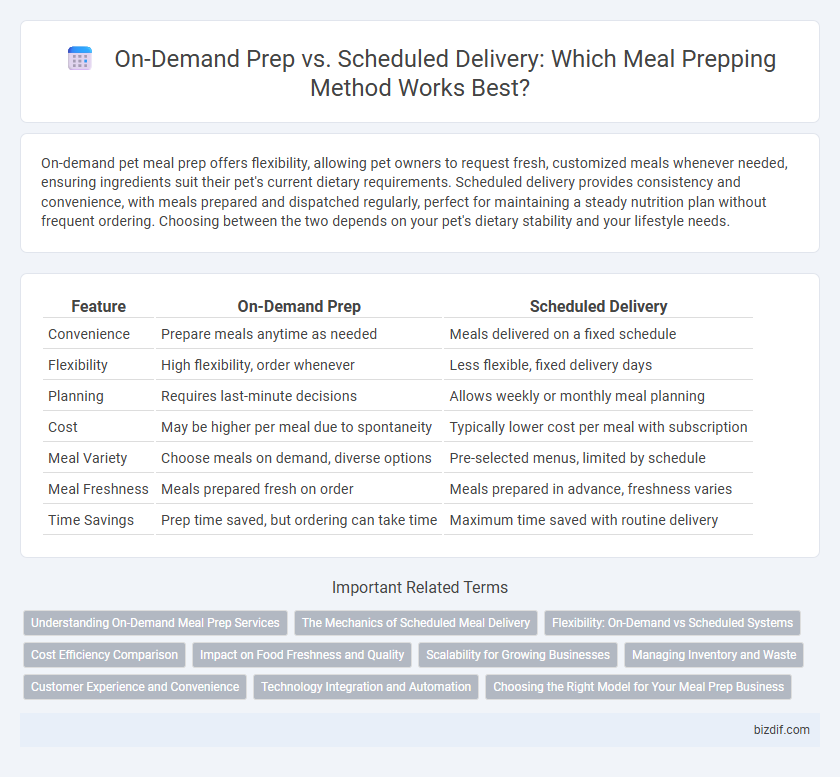On-demand pet meal prep offers flexibility, allowing pet owners to request fresh, customized meals whenever needed, ensuring ingredients suit their pet's current dietary requirements. Scheduled delivery provides consistency and convenience, with meals prepared and dispatched regularly, perfect for maintaining a steady nutrition plan without frequent ordering. Choosing between the two depends on your pet's dietary stability and your lifestyle needs.
Table of Comparison
| Feature | On-Demand Prep | Scheduled Delivery |
|---|---|---|
| Convenience | Prepare meals anytime as needed | Meals delivered on a fixed schedule |
| Flexibility | High flexibility, order whenever | Less flexible, fixed delivery days |
| Planning | Requires last-minute decisions | Allows weekly or monthly meal planning |
| Cost | May be higher per meal due to spontaneity | Typically lower cost per meal with subscription |
| Meal Variety | Choose meals on demand, diverse options | Pre-selected menus, limited by schedule |
| Meal Freshness | Meals prepared fresh on order | Meals prepared in advance, freshness varies |
| Time Savings | Prep time saved, but ordering can take time | Maximum time saved with routine delivery |
Understanding On-Demand Meal Prep Services
On-demand meal prep services offer flexibility by allowing customers to order freshly prepared meals exactly when needed, eliminating the need for advance scheduling. These services use real-time inventory and dynamic kitchen operations to meet immediate demand, providing convenience for individuals with unpredictable schedules. By leveraging technology for instant order processing and delivery, on-demand meal prep enhances accessibility and freshness compared to scheduled meal delivery options.
The Mechanics of Scheduled Meal Delivery
Scheduled meal delivery operates through a systematic process where customers select meals for a predetermined delivery day, allowing providers to batch-prep ingredients and optimize kitchen workflows. This model relies on advanced logistics software to coordinate order timelines, meal customization preferences, and delivery routes, ensuring freshness upon arrival. By integrating customer data analytics, scheduled delivery enhances portion control, reduces food waste, and maximizes operational efficiency in meal prepping services.
Flexibility: On-Demand vs Scheduled Systems
On-demand meal prep offers unparalleled flexibility, allowing users to order meals whenever needed without committing to a fixed schedule. Scheduled delivery systems provide convenience through routine, but lack the adaptability for sudden changes or spontaneous needs. Flexibility between on-demand and scheduled options depends on individual lifestyle preferences and the need for predictability versus immediate access.
Cost Efficiency Comparison
On-demand meal prep services often incur higher costs due to flexible ordering and last-minute preparation, driving up ingredient and labor expenses. Scheduled delivery allows for bulk purchasing and streamlined kitchen operations, significantly reducing per-meal costs. Consumers seeking cost efficiency typically benefit more from scheduled delivery plans that optimize resource allocation and minimize food waste.
Impact on Food Freshness and Quality
On-demand prep ensures meals are freshly made just before pickup or delivery, maximizing flavor, texture, and nutrient retention. Scheduled delivery often requires meals to be prepared in advance and stored, which can lead to diminished freshness and potential quality loss over time. Choosing on-demand prep supports optimal food quality, while scheduled delivery offers convenience at the possible expense of peak freshness.
Scalability for Growing Businesses
On-demand meal prep services offer flexible scalability, enabling growing businesses to adjust order volumes in real-time based on customer demand without overcommitting resources. Scheduled delivery models provide predictable workflows and inventory management, which are advantageous for scaling operations with consistent demand patterns. Balancing on-demand flexibility and scheduled reliability is crucial for meal prep businesses aiming to optimize growth and operational efficiency.
Managing Inventory and Waste
On-demand meal prep allows for precise inventory management by preparing meals only when needed, significantly reducing food waste. Scheduled delivery requires accurate forecasting to balance sufficient stock levels with the risk of excess perishables, which can increase waste if demand fluctuates. Effective inventory tracking systems and real-time data analysis are crucial for minimizing spoilage and optimizing meal ingredient utilization in both models.
Customer Experience and Convenience
On-demand meal prep offers customers the flexibility to order fresh, customized meals whenever needed, enhancing convenience through instant availability and personalized choices. Scheduled delivery models improve customer experience by providing consistency, allowing users to plan meals ahead and reduce daily decision fatigue. Both options prioritize convenience but cater to different lifestyle preferences, with on-demand favoring spontaneity and scheduled delivery emphasizing routine and reliability.
Technology Integration and Automation
On-demand meal prep leverages advanced technology integration and automation to provide instant access to fresh meals tailored to individual preferences, utilizing AI-driven customization and real-time inventory management. Scheduled delivery systems employ automated workflows and predictive analytics to optimize meal preparation timelines, ensuring consistent quality and timely distribution. Both models capitalize on IoT devices and app-based platforms to streamline ordering processes and enhance user convenience.
Choosing the Right Model for Your Meal Prep Business
On-demand prep offers flexibility and freshness by preparing meals only when orders are received, ideal for businesses with variable customer demand and limited storage. Scheduled delivery relies on batch cooking and predetermined delivery times, optimizing efficiency and reducing per-meal costs through economies of scale. Selecting the right model depends on customer preferences, order volume predictability, and operational capabilities to balance quality, cost, and convenience in your meal prep business.
On-Demand Prep vs Scheduled Delivery Infographic

 bizdif.com
bizdif.com